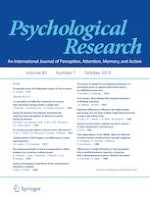24-04-2018 | Original Article
First unitary, then divided: the temporal dynamics of dividing attention
Gepubliceerd in: Psychological Research | Uitgave 7/2019
Log in om toegang te krijgenAbstract
Whether focused visual attention can be divided has been the topic of much investigation, and there is a compelling body of evidence showing that, at least under certain conditions, attention can be divided and deployed as two independent foci. Three experiments were conducted to examine whether attention can be deployed in divided form from the outset, or whether it is first deployed as a unitary focus before being divided. To test this, we adapted the methodology of Jefferies, Enns, and Di Lollo (Journal of Experimental Psychology: Human Perception and Performance 40: 465, 2014), who used a dual-stream Attentional Blink paradigm and two letter-pair targets. One aspect of the AB, Lag-1 sparing, has been shown to occur only if the second target pair appears within the focus of attention. By presenting the second target pair at various spatial locations and assessing the magnitude of Lag-1 sparing, we probed the spatial distribution of attention. By systematically manipulating the stimulus-onset-asynchrony between the targets, we also tracked changes to the spatial distribution of attention over time. The results showed that even under conditions which encourage the division of attention, the attentional focus is first deployed in unitary form before being divided. It is then maintained in divided form only briefly before settling on a single location.
